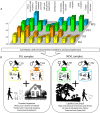First comparative transcriptomic analysis of wild adult male and female Lutzomyia longipalpis, vector of visceral leishmaniasis
- PMID: 23554910
- PMCID: PMC3595279
- DOI: 10.1371/journal.pone.0058645
First comparative transcriptomic analysis of wild adult male and female Lutzomyia longipalpis, vector of visceral leishmaniasis
Abstract
Leishmaniasis is a vector-borne disease with a complex epidemiology and ecology. Visceral leishmaniasis (VL) is its most severe clinical form as it results in death if not treated. In Latin America VL is caused by the protist parasite Leishmania infantum (syn. chagasi) and transmitted by Lutzomyia longipalpis. This phlebotomine sand fly is only found in the New World, from Mexico to Argentina. However, due to deforestation, migration and urbanisation, among others, VL in Latin America is undergoing an evident geographic expansion as well as dramatic changes in its transmission patterns. In this context, the first VL outbreak was recently reported in Argentina, which has already caused 7 deaths and 83 reported cases. Insect vector transcriptomic analyses enable the identification of molecules involved in the insect's biology and vector-parasite interaction. Previous studies on laboratory reared Lu. longipalpis have provided a descriptive repertoire of gene expression in the whole insect, midgut, salivary gland and male reproductive organs. Nevertheless, the study of wild specimens would contribute a unique insight into the development of novel bioinsecticides. Given the recent VL outbreak in Argentina and the compelling need to develop appropriate control strategies, this study focused on wild male and female Lu. longipalpis from an Argentine endemic (Posadas, Misiones) and a Brazilian non-endemic (Lapinha Cave, Minas Gerais) VL location. In this study, total RNA was extracted from the sand flies, submitted to sequence independent amplification and high-throughput pyrosequencing. This is the first time an unbiased and comprehensive transcriptomic approach has been used to analyse an infectious disease vector in its natural environment. Transcripts identified in the sand flies showed characteristic profiles which correlated with the environment of origin and with taxa previously identified in these same specimens. Among these, various genes represented putative targets for vector control via RNA interference (RNAi).
Conflict of interest statement
Figures


Similar articles
-
Metagenomic analysis of taxa associated with Lutzomyia longipalpis, vector of visceral leishmaniasis, using an unbiased high-throughput approach.PLoS Negl Trop Dis. 2011 Sep;5(9):e1304. doi: 10.1371/journal.pntd.0001304. Epub 2011 Sep 6. PLoS Negl Trop Dis. 2011. PMID: 21909446 Free PMC article.
-
Ecological parameters of the (S)-9-methylgermacrene-B population of the Lutzomyia longipalpis complex in a visceral leishmaniasis area in São Paulo state, Brazil.Parasit Vectors. 2017 May 30;10(1):269. doi: 10.1186/s13071-017-2211-8. Parasit Vectors. 2017. PMID: 28558760 Free PMC article.
-
Polymerase chain reaction-based assay for the detection and identification of sand fly gregarines in Lutzomyia longipalpis, a vector of visceral leishmaniasis.J Vector Ecol. 2014 Jun;39(1):83-93. doi: 10.1111/j.1948-7134.2014.12074.x. J Vector Ecol. 2014. PMID: 24820560
-
[Lutzomyia longipalpis and Leishmaniasis visceral in Argentina].Medicina (B Aires). 2001;61(2):174-8. Medicina (B Aires). 2001. PMID: 11374140 Review. Spanish.
-
Lutzomyia longipalpis and the eco-epidemiology of American visceral leishmaniasis, with particular reference to Brazil: a review.Mem Inst Oswaldo Cruz. 2005 Dec;100(8):811-27. doi: 10.1590/s0074-02762005000800001. Epub 2006 Jan 20. Mem Inst Oswaldo Cruz. 2005. PMID: 16444411 Review.
Cited by
-
A comprehensive review of biological and genetic control approaches for leishmaniasis vector sand flies; emphasis towards promoting tools for integrated vector management.PLoS Negl Trop Dis. 2025 Jan 27;19(1):e0012795. doi: 10.1371/journal.pntd.0012795. eCollection 2025 Jan. PLoS Negl Trop Dis. 2025. PMID: 39869587 Free PMC article. Review.
-
De novo assembly and sex-specific transcriptome profiling in the sand fly Phlebotomus perniciosus (Diptera, Phlebotominae), a major Old World vector of Leishmania infantum.BMC Genomics. 2015 Oct 23;16:847. doi: 10.1186/s12864-015-2088-x. BMC Genomics. 2015. PMID: 26493315 Free PMC article.
-
HoSeIn: A Workflow for Integrating Various Homology Search Results from Metagenomic and Metatranscriptomic Sequence Datasets.Bio Protoc. 2020 Jul 20;10(14):e3679. doi: 10.21769/BioProtoc.3679. eCollection 2020 Jul 20. Bio Protoc. 2020. PMID: 33659350 Free PMC article.
-
Soil Metagenomes from Different Pristine Environments of Northwest Argentina.Genome Announc. 2015 Aug 13;3(4):e00926-15. doi: 10.1128/genomeA.00926-15. Genome Announc. 2015. PMID: 26272581 Free PMC article.
-
Differential expression of endogenous plant cell wall degrading enzyme genes in the stick insect (Phasmatodea) midgut.BMC Genomics. 2014 Oct 21;15(1):917. doi: 10.1186/1471-2164-15-917. BMC Genomics. 2014. PMID: 25331961 Free PMC article.
References
Publication types
MeSH terms
Substances
LinkOut - more resources
Full Text Sources
Other Literature Sources
Miscellaneous

